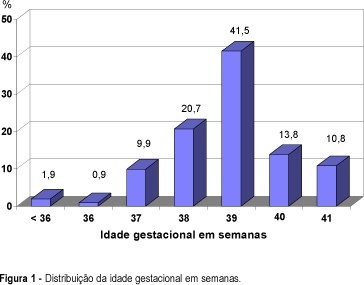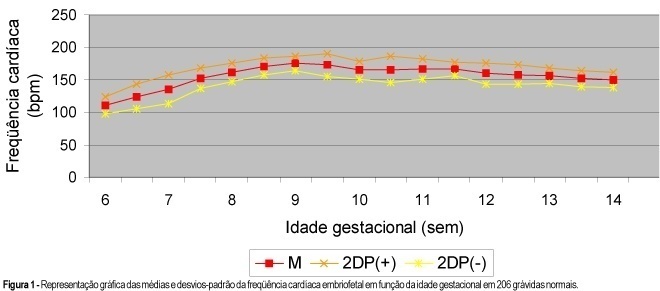Summary
Revista Brasileira de Ginecologia e Obstetrícia. 2023;45(9):551-554
Summary
Revista Brasileira de Ginecologia e Obstetrícia. 1998;20(10):551-555
DOI 10.1590/S0100-72031998001000002
Purpose: to assess the validity of fetal weight estimation by a method based on uterine height -- Johnson's rule. Methods: one hundred and one pregnant women and their newborn children were studied. The fetal weight was estimated using an adaptation of Johnson's rule, which consists of the clinical application of a mathematical model to calculate the fetal weight based on the uterine height and the height of fetal presentation. The estimated weight was obtained on the day of delivery and was compared to the weight observed after birth. This, in turn, was the control of the analysis of validity of the method used. On the same date, a detailed obstetrical ultrasonography (US) was conducted which included the fetal weight, calculated by the use of Sheppard's tables. This weight, estimated by US, was compared to the birth weight. Results: the results have proven that the clinical estimate used in this study has a similar value to that of the US calculation of birth weight. The accuracy of the clinical method, with variations of 5%, 10% and 15% between estimated and observed weights, was 55.3%, 73% and 86.7%, respectively. Those of the US were 60.7%, 75.4% and 91.1%, respectively. When comparing both sets of figures, values were not different from a statistical standpoint. Conclusion: the clinical evaluation has shown to be accurate, similarly to the US, when calculating the birth weight.

Summary
Revista Brasileira de Ginecologia e Obstetrícia. 2004;26(7):551-556
DOI 10.1590/S0100-72032004000700007
PURPOSE: to report three cases of gestational trophoblastic disease with intense hemorrhagic complications, in which exceptional surgical procedures were used to obtain hemostasis. METHODS: the study comprised three patients: the first, a young woman, 27 years old, nullipara, was submitted to total abdominal hysterectomy and, thereafter, to chemotherapy until remission was achieved. Another patient bled from an extensive vaginal metastasis that could only be treated with hypogastric arterial ligation. Definitive sustained remission was obtained after chemotherapy. Two years after the episode, the patient achieved a new, normal pregnancy. The third patient, with persistent trophoblastic disease, presented a mass of molar tissue within the uterine inferior segment and cervix, extending to the right vaginal cul-de-sac, heavily bleeding at each attempt of surgical removal, whether by sharp or suction curettage. As a consequence of the invasive maneuvers she became seriously infected with sepsis; although being submitted to intensive antibiotic therapy and total abdominal hysterectomy she died a few days later. RESULTS: of the two patients who were submitted to total abdominal hysterectomy, one survived and the other died of septicemia. The third patient, who was submited to hypogastric arterial ligation, had a favorable outcome and achieved a new and normal pregnancy. CONCLUSION: albeit gestational trophoblastic disease usually has an undisturbed course and spontaneous remission, unexpected complications may demand radical approaches leading sometimes to unfavorable results.
Summary
Revista Brasileira de Ginecologia e Obstetrícia. 2000;22(9):551-555
DOI 10.1590/S0100-72032000000900003
Purpose: to evaluate the evolution in the embryo heart rate in the first trimester of pregnancy. Patients and Methods: in a prospective study 206 pregnant women were evaluated in the first trimester of pregnancy, by transvaginal color Doppler sonography, using Aloka, SSD-2000 apparatus, with a 5-MHz transvaginal transducer. All examinations were performed by the same examiner, with the determination of embryo heart rate. The patients were classified into groups according to the gestational age, in half-week intervals from the 5th week of pregnancy on. Pregnancy outcome was evaluated by ultrasonography at the end of second and third trimesters. Mean and standard deviation were determined for each evaluated gestational age. Results: it was possible to determine normal values for embryo heart rate. Mean embryo heart rate showed changes with gestational age, ranging from 110 ± 14 bpm at the 6.0th week to 150 ± 12 bpm at the 14.0th week. Conclusions: transvaginal pulsed color Doppler equipment enabled cardiovascular evaluation in early pregnancy, being a noninvasive method and innocuous to the embryo. These values would be useful in new studies on dopplervelocimetry in this period of pregnancy.

Summary
Revista Brasileira de Ginecologia e Obstetrícia. 2001;23(9):551-551
Summary
Revista Brasileira de Ginecologia e Obstetrícia. 2017;39(10):552-559
Resident doctors usually face the task to communicate bad news in perinatology without any formal training. The impact on parents can be disastrous. The objective of this paper is to analyze the perception of residents regarding a training program in communicating bad news in perinatology based on video reviews and setting, perception, invitation, knowledge, emotion, and summary (SPIKES) strategy.
We performed the analysis of complementary data collected from participants in a randomized controlled intervention study to evaluate the efficacy of a training program on improving residents’ skills to communicate bad news. Data were collected using a Likert scale. Through a thematic content analysis we tried to to apprehend the meanings, feelings and experiences expressed by resident doctors in their comments as a response to an open-ended question. Half of the group received training, consisting of discussions of video reviews of participants’ simulated encounters communicating a perinatal loss to a “mother” based on the SPIKES strategy. We also offered training sessions to the control group after they completed participation. Twenty-eight residents who were randomized to intervention and 16 from the control group received training. Twenty written comments were analyzed.
The majority of the residents evaluated training highly as an education activity to help increase knowledge, ability and understanding about breaking bad news in perinatology. Three big categories emerged fromresidents’ comments: SPIKES training effects; bad news communication in medical training; and doctors’ feelings and relationship with patients.
Residents took SPIKES training as a guide to systematize the communication of bad news and to amplify perceptions of the emotional needs of the patients. They suggested the insertion of a similar training in their residency programs curricula.
Summary
Revista Brasileira de Ginecologia e Obstetrícia. 2016;38(11):552-558
Whether preconception elevated concentrations of thyroid-stimulating hormone (TSH) compromises reproductive outcomes in patients undergoing assisted reproduction techniques (ARTs) remains unclear. This study therefore compared the reproductive outcomes in patients with TSH concentrations of < 2.5 mIU/L, 2.5-4.0 mIU/L, and 4.0-10.0mIU/L undergoing controlled ovarian stimulation (COS) for in vitro fertilization (IVF)/intracytoplasmic sperm injection (ICSI).
This retrospective cohort study evaluated the medical records of all women with measured TSH concentrations who underwent IVF/ICSI between January 2011 and December 2012. The patients were divided into three groups: TSH < 2.5mIU/L (group 1); THS ≥2.5 and < 4.0 mIU/L (group 2); and THS ≥4 mIU/L and < 10.0 mIU/L (group 3). Patients who were administered levothyroxine for treating hypothyroidism were excluded from the analysis. The primary endpoints were clinical pregnancy,miscarriage, live birth and multiple pregnancy rates.
During the study period, 787 women underwent IVF/ICSI. Sixty were excluded because their TSH concentrations were unavailable, and 77 were excluded due to their use of levothyroxine. The prevalence of patients presenting elevated concentrations of TSHwas of 5.07% (using a TSH threshold of 4.0 mIU/L) and of 29.99% (using a TSH threshold of 2.5 mIU/L). Patient characteristics, type of COS, and response to COS did not differ among the three groups, and there were no differences in clinical pregnancy (24.4% versus 25.9% versus 24.2%, p = 0.93); miscarriage (17.1% versus 14.3% versus 12.5%, p = 0.93); live birth (20.2% versus 22.2% versus 21.2%, p = 0.86); and multiple pregnancy rates (27.0% versus 21.4% versus 25.0%, p = 0.90) respectively.
Response to COS, live birth, and miscarriage rates were not altered in women with elevated concentrations of TSH undergoing IVF/ICSI, regardless of using a TSH threshold of 2.5mIU/L or 4.0mIU/L. These findings reinforce the uncertainties related to the impact of subclinical hypothyroidism on reproductive outcomes in women undergoing COS for ARTs.
Summary
Revista Brasileira de Ginecologia e Obstetrícia. 2015;37(12):552-558
DOI 10.1590/SO100-720320155443
To compare differences in the occurrence and changed domains of sexual dysfunction in obese and non-obese Brazilian women.
Female Sexual Function Index, based on six domains, to investigate 31 sexual dysfunction incidence for obese compared to 32 non-obese women, was used. Statistical analysis using ANOVA and MANOVA were performed to compare total scores of Female Sexual Function Index among groups and to identify the differences among domains, Student t -test was used. Statistical significant level was established for all tests for p<0.05.
No difference in female sexual dysfunction frequency between obese (25.8%) and non-obese women (22.5%) was found. However, an important distinction in which aspects of sexual life were affected was found. While the obese group was impaired in three domains of sexual life (desire, orgasm, and arousal), in the control group five aspects were dysfunctional (desire, orgasm, arousal, pain and lubrication). Future research exploring psychological outcomes in obese females, such as body image and measures of positive and negative effect, might better characterize the female sexual dysfunction in this group.
Obesity does not appear to be an independent factor for allow quality of female sexual life. However, disturbance associated to obesity indicates a low frequency of disorder in physical domains, suggesting that psychological factors seem to be mainly involved in the sexual dysfunction in obese women.